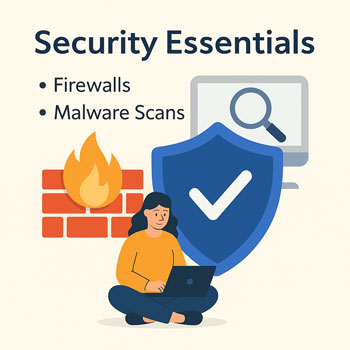
Security Essentials (Firewalls & Malware Scans)
Keeping WordPress secure is an ongoing process. Use a web application firewall (WAF), schedule malware scans, harden login access, and maintain backups so you can recover quickly if anything goes wrong.
1) Core Principles
- Least privilege: Only give users the access they need (Editor, Shop Manager, etc.).
- Layers of defense: Hosting security + CDN/WAF + WordPress firewall plugin + strong access controls.
- Visibility & response: Logging, alerts, scheduled scans, and a tested recovery plan.
Quick win: Enable 2FA for all Administrator accounts and disable file editing in the dashboard.
2) Choose Your Firewall
CDN / Edge WAF
- Cloudflare WAF: Blocks threats before they reach your server; add rules, rate limiting, bot fight mode.
- Host-provided WAF: Some managed hosts include edge firewalls and DDoS protection.
- Best for: Broad attack filtering, performance boost via CDN.
Plugin / Application WAF
- Wordfence: Endpoint firewall, malware scanner, login security.
- NinjaFirewall / iThemes Security / Sucuri: Rulesets, hardening, and alerts.
- Best for: WordPress-specific rules, easy per-site management.
Use one main firewall layer in WordPress. Running multiple security plugins with overlapping features can cause conflicts.
3) Recommended Baseline Settings
- Force HTTPS (SSL) and enable HSTS at the edge (if available).
- 2-Factor Authentication for all Admins; require strong passwords for all users.
- Login protection: Limit login attempts, enable reCAPTCHA/turnstile, and rename/hide
wp-login.phpif offered.
- Login protection: Limit login attempts, enable reCAPTCHA/turnstile, and rename/hide
- XML-RPC: Disable or restrict; allowlist Jetpack/mobile IPs only if you need it.
- File editing off: Add
define('DISALLOW_FILE_EDIT', true);towp-config.php.
- File editing off: Add
- Firewall rules: Block common exploits (SQLi/XSS), rate-limit
/wp-login.phpand/xmlrpc.php, block countries/bots if relevant.
- Firewall rules: Block common exploits (SQLi/XSS), rate-limit
- Security headers: Add Content-Security-Policy (start with report-only), X-Frame-Options, X-Content-Type-Options, and Referrer-Policy via host or plugin.
4) Malware Scans & Integrity Checks
- Schedule scans (daily/weekly): core files, themes, plugins, uploads for suspicious files, backdoors, and modified core.
- File change detection: Alert when files are added/edited; review diffs for unexpected changes.
- Blacklist checks: Monitor search engine and security vendor blocklists.
- Quarantine or auto-repair infected core files; always review before deleting in uploads.
Never clean without a backup. Verify you have a recent, off-site backup before removing or repairing files.
5) Hardening Checklist
- Keep everything updated: WordPress core, themes, plugins. Remove anything unused.
- Backups: Daily database + weekly full files; store off-site (S3/Drive) with 30–90 day retention. Test restores.
- Least privilege users: Convert old Admins to lower roles or remove; use separate admin account (no blogging as Admin).
- Lock down wp-admin: Optional IP allowlist or HTTP Auth for high-risk sites.
- Disable directory indexing and restrict
wp-contentexecution where possible.
- Disable directory indexing and restrict
- Enforce plugin/theme integrity (block nulled software) and verify signatures/hashes when available.
6) Incident Response (If You Suspect a Hack)
- Isolate: Put the site in maintenance mode or restrict traffic via WAF; take a fresh backup for forensics.
- Scan with your security plugin and at the server/edge; check recent file changes and admin users.
- Clean: Quarantine or remove malicious files; replace core, theme, plugin files from official sources.
- Reset credentials: All WordPress users, hosting panel, SFTP/SSH, database, API keys.
- Patch & harden: Update components, close entry points (vulnerable plugins, weak passwords, exposed endpoints).
- Request blacklist review (if flagged) and monitor logs for recurring activity.
7) Example Configs (Practical Defaults)
Cloudflare (Free/Pro)
- Enable WAF Managed Rules + Bot Fight.
- Rate-limit
/wp-login.phpand/xmlrpc.php(e.g., 5 req / 10s).
- Rate-limit
- Always Use HTTPS + HSTS; set Security Level to Medium/High.
Wordfence / iThemes
- Firewall: Enabled & Learning Mode for 1–2 days, then Enabled & Protecting.
- Brute force: limit to 5–10 retries; lock out 10–30 min; enable reCAPTCHA/Turnstile.
- Scans: schedule daily; enable file change detection + email alerts.
WooCommerce Notes
- Never cache Cart/Checkout/My Account pages; exclude from WAF rules that block cookies/sessions.
- Require 2FA for Admins/Shop Managers; enable fraud/abuse protection at gateway/CDN.
- Log webhook endpoints and allowlist them in firewall rate limits.
8) Final Security Checklist
- Edge or plugin firewall enabled and tested.
- 2FA + strong passwords for all privileged users.
- Login rate limiting + CAPTCHA/Turnstile active.
- XML-RPC restricted; file editing disabled.
- Scheduled malware scans and file change alerts.
- Backups off-site with recent restore test.
- Security headers and HTTPS/HSTS configured.
- Incident response steps documented.
